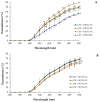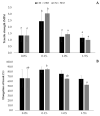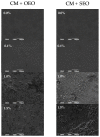Chia Seed Mucilage Edible Films with Origanum vulgare and Satureja montana Essential Oils: Characterization and Antifungal Properties
- PMID: 35207134
- PMCID: PMC8875529
- DOI: 10.3390/membranes12020213
Chia Seed Mucilage Edible Films with Origanum vulgare and Satureja montana Essential Oils: Characterization and Antifungal Properties
Abstract
Films made with mucilage obtained from defatted chia seeds and incorporated with oregano (Origanum vulgare) and savory (Satureja montana) essential oils (0.1,1.0 and 1.5% v/v) were prepared to evaluate their physical, optical, mechanical and antifungal properties as well as their microstructure. The use of different types of essential oils (oregano or savory) only had a significant effect on the light transmittance, total color difference (∆E) and antifungal activity of the films. However, the kind of essential oil was not significant for the physical, optical and mechanical properties of the films. Increasing concentrations of essential oils up to 1.5% v/v led to a decrease in tensile strength (TS) and elongation at break (EB). Antifungal properties significantly increased with the incorporation of essential oils (p < 0.05). The antifungal activity of the chia mucilage films incorporated with O. vulgare and S. montana essential oil was screened by agar disc-diffusion assay against five mold strains commonly found in foods. Films containing 0.1% v/v of essential oils were not active, whereas films containing 1.0 and 1.5% v/v were very effective at inhibiting the growth of the tested mold strains (38.01-77.66%). Scanning electron microscopy showed that incorporation of essential oils caused some heterogeneity in the films and the surface displayed no pores or cracks as well as a better integration of oregano EO in the polymeric network. The results pointed out that the incorporation of oregano and savory essential oils as a natural antimicrobial agent has appreciable potential for the development of films as active packaging to control mold contamination and increase food safety.
Keywords: antifungal activity; bioactive films; chia by-products; chia mucilage films; essential oils.
Conflict of interest statement
The authors declare no conflict of interest.
Figures



References
-
- Han Y., Yu M., Wang L. Physical and antimicrobial properties of sodium alginate/carboxymethyl cellulose films incorporated with cinnamon essential oil. Food Packag. Shelf Life. 2017;15:35–42. doi: 10.1016/j.fpsl.2017.11.001. - DOI
-
- Hosseini S.F., Rezaei M., Zandi M., Farahmandghavi F. Bio-based composite edible films containing Origanum vulgare L. essential oil. Ind. Crops Prod. 2015;67:403–413. doi: 10.1016/j.indcrop.2015.01.062. - DOI
-
- Soukoulis C., Gaiani C., Hoffmann L. Plant seed mucilage as emerging biopolymer in food industry applications. Curr. Opin. Food Sci. 2018;22:28–42. doi: 10.1016/j.cofs.2018.01.004. - DOI
Grants and funding
- RTA2015-00018-C03-02/Spanish National Institute for Agricultural Research and Experimentation, INIA
- Ramón y Cajal Fellowships RyC-2014-16307/Ministerio de Ciencia e Innovación, Spain
- Operational Program for Youth Employment 518 2014/2020 of Castile-La Mancha/European Social Found-Resional Government of Castilla-La Mancha
- Predoctoral contract N. Muñoz-Tebar/European Social Found-University of Castilla-La Mancha
LinkOut - more resources
Full Text Sources

